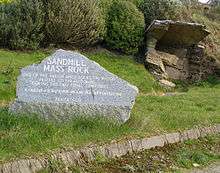Mass rock
A Mass rock (Carraig an Aifrinn in Irish) was a rock used as an altar in mid-17th century Ireland as a location for Roman Catholic Mass. Isolated locations were sought to hold religious ceremonies, as observing the Catholic Mass was a matter of difficulty and danger at the time as a result of both Cromwell's campaign against the Irish, and the Penal Law of 1695. Bishops were banished and priests had to register to preach under the 1704 Registration Act. Priest hunters were employed to arrest unregistered priests and Presbyterian preachers under an Act of 1709.

In many instances a stone would be taken from a church ruin, and relocated to a rural area, with a simple cross carved on its top. Because the activity was illegal, the services were not scheduled and parishioners would be obliged to spread the word of them informally. By the late 17th century worship generally moved to thatched Mass houses. Some of the Mass rock places may have been used for patterns.
Similar stones, known as Mass stones, are found in Scotland. Presbyterians held similar Conventicles and these were also outlawed, even though they were not religious ceremonies.
For Lutherans during the Counter-Reformation in Austria, a similar stone in Paternion was dubbed the hundskirche.
Partial data on Mass rocks is maintained by the Archaeological Survey of Ireland (for pre-1700 sites)[1] and, to a lesser extent, the National Inventory of Architectural Heritage (for post-1700 sites).[2]
See also
- "Have you been at Carrick?" — folk song about attending a Mass rock service
References
Sources
- Denis Power (1992). Archaeological Inventory of County Cork, Volume 3: Mid Cork, 1997, Duchas The Heritage Society. ISBN 0-7076-4933-1
Citations
- "Historic Environment Viewer". National Monuments Service. Retrieved 27 March 2020. [ Filter dataset "National Monuments Service" and Type "Mass-rock", "Mass-rock (current location)", and/or "Penal Mass station"]
- "Buildings Search: Mass rock". Buildings of Ireland. National Inventory of Architectural Heritage. Retrieved 27 March 2020.